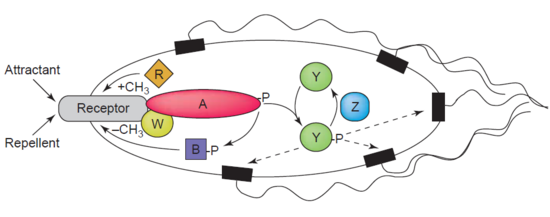User:Hundleyz/sandbox
Demethylases are enzymes that remove methyl (CH3-) groups from proteins, histones, nucleic acids, and other molecules. Demethylase enzymes are important in epigenetic modification mechanisms. The demethylase proteins alter transcriptional regulation of the genome by controlling the methylation levels that occur on DNA and histones and, in turn, regulate the chromatin state at specific gene loci within organisms.
Oxidative demethylation[edit]
Histone Demethylation[edit]
For many years histone methylation was thought to be irreversible, due to the fact that the half-life of methylated histones was approximately equal to that of unmethylated histones.[1] In 2004, Shi et al. published their discovery of LSD1 (later classified as KDM1A), a nuclear amine oxidase homolog.[2] With the new found interest in epigenetics, many more families of histone demethylases have been found. Defined by their mechanisms, two main classes of histone demethylases exist: a flavin adenine dinucleotide (FAD)-dependent amine oxidase, and an Fe(II) and α-ketoglutarate-dependent dioxygenase.[3]

There are several families of histone demethylases, which act on different substrates and play different roles in cellular function. Histone demethylation comes with its own specific system for labeling the substrate of the demethylase protein. The substrate is first specified by the histone name and then the one letter designation and number of the amino acid that is methylated. Lastly, the level of methylation is sometimes noted by the addition of "me#", with the numbers being 1(mono-), 2(di-), and 3(tri-). For example, H3K9me2 is histone H3 with the lysine in the ninth position being di-methylated.
The KDM1 family includes KDM1A and KDM1B. KDM1A (also referred to as LSD1/AOF2/BHC110) can act on mono- and di-methylated H3K4 and H3K9, while KDM1B (also referred to as LSD2/AOF1) acts only on mono- and di-methylated H3K4. Both these enzymes have roles in critical embryogenesis and tissue-specific differentiation.[1]
The KDM2 family includes KDM2A and KDM2B. KDM2A (also referred to as JHDM1A/FBXL11) can act on mono- and di-methylated H3K36 and trimethylated H3K4, while KDM2B (also referred to as JHDM1B/FBXL10) acts only on mono- and di-methylated H3K36. KDM2A has roles in either promoting or inhibiting tumor function, while KDM2B has roles in oncogenesis.[1]
The KDM3 family includes KDM3A, KDM3B and JMJD1C. KDM3A (also referred to as JHDM2A/JMJD1A/TSGA) can act on mono- and di-methylated H3K9, while the substrates for KDM3B (also referred to as JHDM2B/JMJD1B) and JMJD1C (also referred to as JHDM2C/TRIP8) are not known. The KDM3A has roles in spermatogenesis and metabolic functions, while the roles are of KDM3B and JMJD1C are unknown.[1]
The KDM4 family includes KDM4A, KDM4B, KDM4C, and KDM4D. These are also referred to as JMDM3A/JMJD2A, JMDM3B/JMJD2B, JMDM3C/JMJD2C, JMDM3D/JMJD2D, respectively. These enzymes can act on di- and tri-methylated H3K9, H3K36, H1K26. KDM4B and KDM4C have roles in tumorigenesis, while the roles of KDM4A and KDM4D are unknown.[1]
The KDM5 family includes KDM5A, KDM5B, KDM5C, and KDM5D. These are also referred to as JARID1A/RBP2, JARID1B/PLU-1, JARID1C/SMCX, JARID1D/SMCY, respectively. These enzymes can act on di- and tri-methylated H3K4 and have roles in development.[1]
The KDM6 family includes KDM6A, KDM6B, and UTY. KDM6A (also referred to as UTX) and KDM6B (also referred to as JMJD3) act on di- and tri-methylated H3K27 and have roles in development, while the substrate and role of UTY is unknown.[1]
Ester Demethylation[edit]
Another example of a demethylase is protein-glutamate methylesterase, also known as CheB protein (EC 3.1.1.61), which demethylates MCPs (methyl-accepting chemotaxis proteins) through hydrolysis of carboxylic ester bonds. The association of a chemotaxis receptor with an agonist leads to the phosphorylation of CheB. Phosphorylation of CheB protein enhances its catalytic MCP demethylating activity resulting in adaption of the cell to environmental stimuli.[4] MCPs respond to extracellular attractants and repellents in bacteria like E. coli in chemotaxis regulation. CheB is more specifically termed a methylesterase, as it removes methyl groups from methylglutamate residues located on the MCPs through hydrolysis producing glutamate accompanied by the release of methanol.[5]
CheB is of particular interest to researchers as it may be a therapeutic target for mitigating the spread of bacterial infections.[6]

See also[edit]
References[edit]
- ^ a b c d e f g Pedersen, M.T. & Helin K. "Histone Demethylases in Development and Diesease" Cell Trends in Cell Biology. Nov, 2010;20,11:662-71. {{doi:http://dx.doi.org/10.1016/j.tcb.2010.08.011}}
- ^ Shi, Y.; Lan, F.; Matson, C.; Mulligan, P; Wheststine, J.R.; Cole, P.A.; Casero, R.A. & Shi, Y. "Histone Demethylation Mediated by the Nuclear Amine Oxidase Homolog LSD1" Cell. Dec 29, 2004;119:941-53. {{doi:10.1016/j.cell.2004.12.012}}
- ^ Klose RJ & Zhang Y. 2007. "Regulation of histone methylation by demethylimination and demethylation" Nature Reviews Mol. Cell Biology. April 2007;8:307-18. {{doi:http://dx.doi.org/10.1038/nrm2143}}
- ^ a b Vladimirov, Nikita, et al. "Dependence of bacterial chemotaxis on gradient shape and adaptation rate." PLoS computational biology 4.12 (2008): e1000242.
- ^ Park, Borbat, et al. Reconstruction of the chemotaxis receptor-kinase assembly, Nature Structural & Molecular Biology 13, 400-407 (2006). 23 April 2006
- ^ West, Ann H., Erik Martinez-Hackert, and Ann M. Stock. "Crystal structure of the catalytic domain of the chemotaxis receptor methylesterase, CheB." Journal of molecular biology 250.2 (1995): 276.
Category:Enzymes Category:EC 3.1.1 Category:EC 1.14.11 Category:EC 1.5.8 Category:Signal transduction
